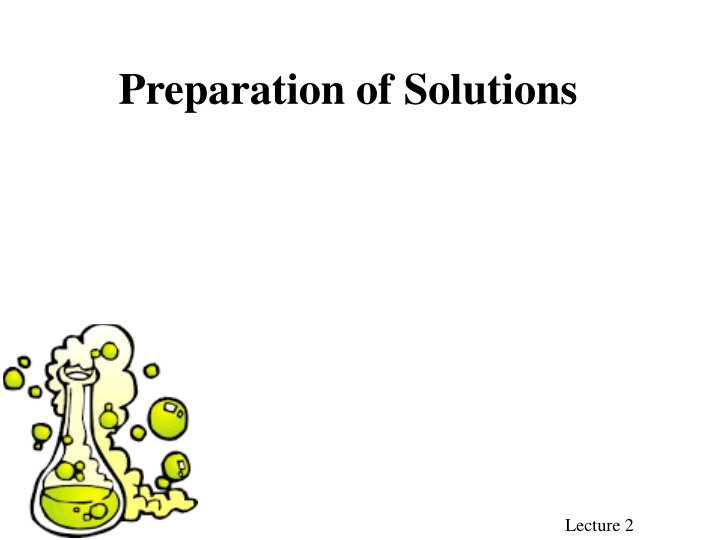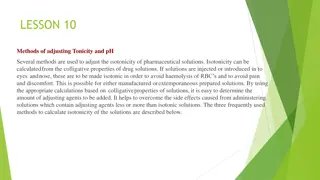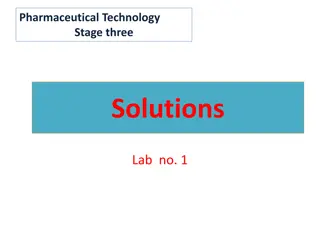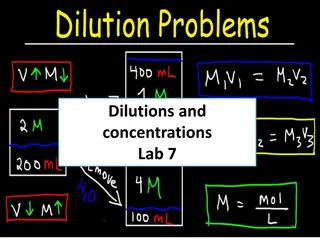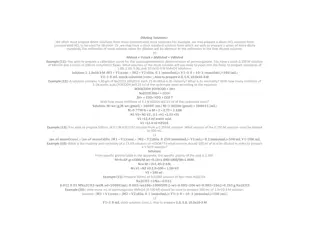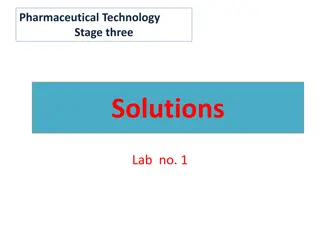Preparation of Solutions
Learn the essential steps for preparing solutions - from solid materials and liquids to dilution techniques. Explore the process of serial dilution and understand how to calculate concentrations effectively.
Download Presentation

Please find below an Image/Link to download the presentation.
The content on the website is provided AS IS for your information and personal use only. It may not be sold, licensed, or shared on other websites without obtaining consent from the author.If you encounter any issues during the download, it is possible that the publisher has removed the file from their server.
You are allowed to download the files provided on this website for personal or commercial use, subject to the condition that they are used lawfully. All files are the property of their respective owners.
The content on the website is provided AS IS for your information and personal use only. It may not be sold, licensed, or shared on other websites without obtaining consent from the author.
E N D
Presentation Transcript
Preparation of Solutions chemical preparation cartoon Lecture 2
Preparation of Solutions It could be prepared either from: 1- Solid material. 2-Liquid.
Preparation of Solutions from Solid Material In general it follows a 4 steps: 1. Weigh the solute. 2. Dissolve the solute. 3. Make up the solution to a known volume. 4. Homogenise. meniscus flask
Preparation of Solutions from Liquid Solutions are often prepared by diluting a more concentrated stock solution. 1. A known volume of the stock solution is transferred to a new container. 2. Make up the solution to a known volume. 3. Homogenize
Dilution It is the procedure for preparing a less concentrated solution from a more concentrated one. When a solution is diluted, solvent is added to lower its concentration. The amount of solute remains constant before and after the dilution: moles BEFORE = moles AFTER. To calculate the concentration: C1 V1 = C2V2 C1 = concentration of stock V1 = Volume of stock C2 = concentration of diluted V2= Volume of diluted
Dilution Continue Always remember that the number of moles DOES NOT CHANGE.
Dilution Continue Example A bottle of 0.5M standard sucrose stock solution is in the lab. How can you use the stock solution to prepare 250 mL of a 0.348M sucrose solution? C1* V1= C2 * V2 0.5 * V1= 0.348 * 0.25 L 0.348 * 0.25 / 0.5 = 0.174 L i.e: 174 ml of the stock solution will be diluted with water to reach the volume of 250 ml.
Serial Dilution The progressive dilution of a substance or infectious agent in a series of tubes or wells in a tray in predetermined ratios. Dilution starts first with stock solution and each diluted solution produced is used to prepare the next. A serial dilution is any dilution where the concentration decreases by the same quantity in each successive step. To calculate the concentration use the equation: C1 V1 = C2V2 l
Linear Dilution Same stock solution is used to produce samples of different concentrations. To calculate the concentration: C1 V1 = C2V2
Dilution Factor Dilution factor refers to the ratio of the volume of the initial (concentrated) solution to the volume of the final (dilute) solution. To make a dilute solution without calculating concentrations use a dilution factor. Divide the final volume by the initial volume. DF=Vf / Vi Vi = initial volume Vf = final volume (aliquot volume + diluent volume) DF of 100 = ratio 1:100
Dilution Factor Continue Example: What is the dilution factor if you add 0.1 ml aliquot of a specimen to 9.9 ml of diluent? The final volume is equal to the aliquot volume PLUS the diluent volume: 0.1 mL + 9.9 mL = 10 mL The dilution factor is equal to the final volume divided by the aliquot volume: 10 mL/0.1 mL = 1:100 dilution.
Dilution Factor Continue Example: What is the dilution factor when 0.2 ml is added to 3.8 ml diluent? Dilution factor = final volume/aliquot volume Final volume = 0.2 +3.8 = 4.0 ml Aliquot volume = 0.2 ml 4.0/0.2 = 1:20 dilution.
Dilution Factor Continue Example: From the previous example if you had 4 tubes what would be the final dilution of tube 4? Since each dilution is 1:20 and we want to know the dilution of the FORTH tube so in this case it would be 1:20 multiplied FOUR times. = 1:20 * 1:20 * 1:20 *1:20 = 1:160,000
Importance of Dilution Example: A blood glucose of 800 mg/dl was obtained. According to the manufacturer the highest glucose result which can be obtained on this particular instrument is 500 mg/dl. The sample must be diluted. The serum was diluted 1:10 and retested. The result is 80 mg/dL. THIS IS NOT THE REPORTALBE RESULT! You must multiply by the dilution factor of 10. 10 x 80 = 800 mg/dl.
